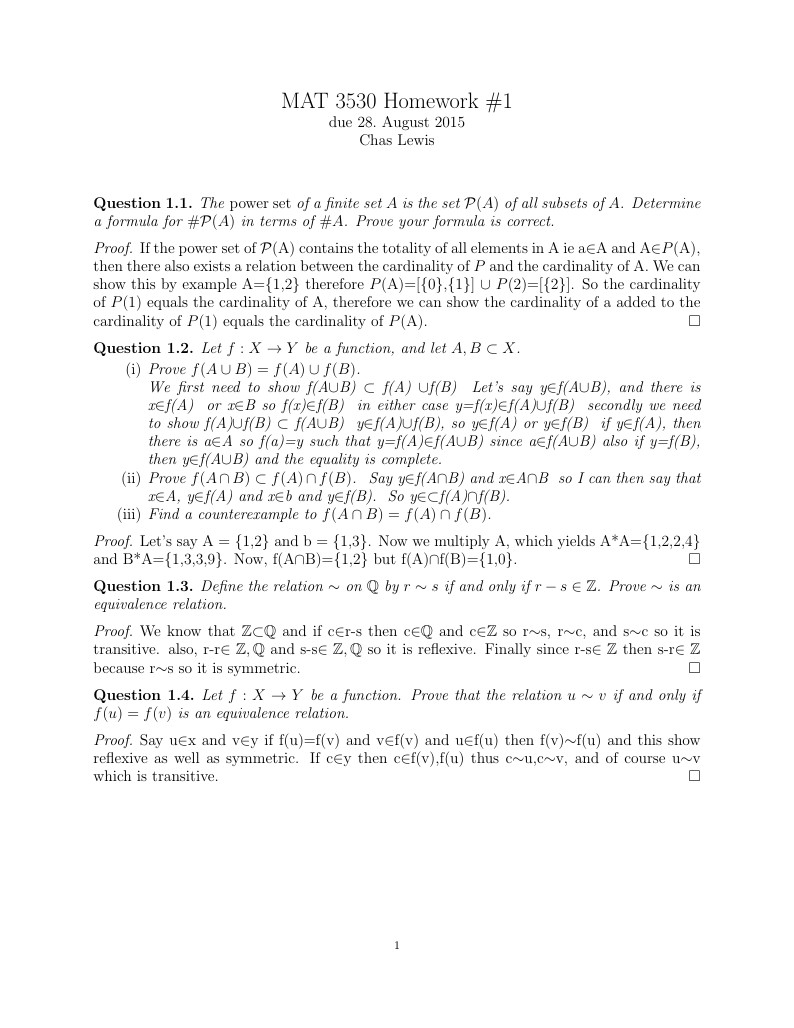
Abstract Algebra Homework #1
Autor:
Chas Lewis
Last Updated:
hace 10 años
License:
LaTeX Project Public License 1.3c
Resumen:
First abstract algebra home work.

\begin
Discover why over 20 million people worldwide trust Overleaf with their work.
First abstract algebra home work.

\begin
Discover why over 20 million people worldwide trust Overleaf with their work.
\documentclass[12pt,twoside]{amsart}
\special{papersize=8.5in,11in}
\usepackage{amssymb}
\usepackage[margin=1in]{geometry}
\usepackage{graphicx}
\usepackage[pdfpagemode=UseOutlines,bookmarksopen=false,letterpaper,bookmarksnumbered=true,pdfborder={0 0 0},colorlinks=false]{hyperref}
% -- Symbols
\newcommand{\CC}{\mathbb{C}}
\newcommand{\NN}{\mathbb{N}}
\newcommand{\QQ}{\mathbb{Q}}
\newcommand{\RR}{\mathbb{R}}
\newcommand{\ZZ}{\mathbb{Z}}
\DeclareMathOperator{\lcm}{lcm}
\newcommand{\st}{\ensuremath{\colon\,}} % such that
\newcommand{\dcup}{\ensuremath{\,\mathaccent\cdot\cup\,}} % disjoint union
\newcommand{\ddd}{\ensuremath{\dcup \cdots \dcup}} % many disjoint unions
\def\urltilda{\kern -.15em\lower .7ex\hbox{\~{}}\kern .04em}
% -- Alterations
\renewcommand{\labelenumi}{(\roman{enumi})}
\numberwithin{figure}{section}
\numberwithin{equation}{section}
% -- Theorem-like Environments
\newtheorem{theorem}{Theorem}[section]
\newtheorem{lemma}[theorem]{Lemma}
\newtheorem{proposition}[theorem]{Proposition}
\newtheorem{corollary}[theorem]{Corollary}
\newtheorem{conjecture}[theorem]{Conjecture}
\newtheorem{claim}[theorem]{Claim}
\newtheorem{assumption}[theorem]{Assumption}
\newtheorem{question}[theorem]{Question}
\theoremstyle{definition}
\newtheorem{definition}[theorem]{Definition}
\newtheorem{remark}[theorem]{Remark}
\newtheorem{notation}[theorem]{Notation}
\newtheorem{example}[theorem]{Example}
\newtheorem*{acknowledgement}{Acknowledgement}
%------------
% -- Document
\begin{document}
\setcounter{section}{1} % Homework Number
\begin{center}
{\Large MAT 3530 Homework \#1} \\
due 28.\ August 2015 \\
Chas Lewis
\end{center}~\\
\begin{question}
The \emph{power set} of a finite set $A$ is the set $\mathcal{P}(A)$ of all subsets of $A$.
Determine a formula for $\#\mathcal{P}(A)$ in terms of $\#A$. Prove your formula is correct.
\end{question}
\begin{proof}
If the power set of $\mathcal{P}$(A) contains the totality of all elements in A ie a$\in$A and A$\in$${P}$(A), then there also exists a relation between the cardinality of ${P}$ and the cardinality of A. We can show this by example A=\{1,2\} therefore ${P}$(A)=[\{0\},\{1\}] $\cup$ ${P}$(2)=[\{2\}]. So the cardinality of ${P}$(1) equals the cardinality of A, therefore we can show the cardinality of a added to the cardinality of ${P}$(1) equals the cardinality of ${P}$(A).
\end{proof}
\begin{question}
Let $f: X \to Y$ be a function, and let $A, B \subset X$.
\begin{enumerate}
\item Prove $f(A \cup B) = f(A) \cup f(B)$.\\
We first need to show f(A$\cup$B) $\subset$ f(A) $\cup$f(B) \
Let's say y$\in$f(A$\cup$B), and there is x$\in$f(A) \
or x$\in$B so f(x)$\in$f(B) \
in either case y=f(x)$\in$f(A)$\cup$f(B) \
secondly we need to show f(A)$\cup$f(B) $\subset$ f(A$\cup$B) \
y$\in$f(A)$\cup$f(B), so y$\in$f(A) or y$\in$f(B) \
if y$\in$f(A), then there is a$\in$A so f(a)=y such that y=f(A)$\in$f(A$\cup$B) since a$\in$f(A$\cup$B)\
also if y=f(B), then y$\in$f(A$\cup$B) and the equality is complete.\
\item Prove $f(A \cap B) \subset f(A) \cap f(B)$. \
Say y$\in$f(A$\cap$B) and x$\in$A$\cap$B \
so I can then say that x$\in$A, y$\in$f(A) and x$\in$b and y$\in$f(B). \
So y$\in$$\subset$f(A)$\cap$f(B).
\item Find a counterexample to $f(A \cap B) = f(A) \cap f(B)$.\
\end{enumerate}
\end{question}
\begin{proof}
Let's say A = \{1,2\} and b = \{1,3\}. Now we multiply A, which yields A*A=\{1,2,2,4\} and B*A=\{1,3,3,9\}. Now, f(A$\cap$B)=\{1,2\} but f(A)$\cap$f(B)=\{1,0\}.
\end{proof}
\begin{question}
Define the relation $\sim$ on $\QQ$ by $r \sim s$ if and only if $r - s \in \ZZ$. Prove $\sim$ is an equivalence relation.
\end{question}
\begin{proof}
We know that $\mathbb{Z}$$\subset$$\mathbb{Q}$ and if c$\in$r-s then c$\in$$\mathbb{Q}$ and c$\in$$\mathbb{Z}$ so r$\sim$s, r$\sim$c, and s$\sim$c so it is transitive. also, r-r$\in\ZZ,\QQ$ and s-s$\in\ZZ,\QQ$ so it is reflexive. Finally since r-s$\in\ZZ$ then s-r$\in\ZZ$ because r$\sim$s so it is symmetric.
\end{proof}
\begin{question}
Let $f: X \to Y$ be a function. Prove that the relation $u \sim v$ if and only if $f(u) = f(v)$ is an equivalence relation.
\end{question}
\begin{proof}
Say u$\in$x and v$\in$y if f(u)=f(v) and v$\in$f(v) and u$\in$f(u) then f(v)$\sim$f(u) and this show reflexive as well as symmetric. If c$\in$y then c$\in$f(v),f(u) thus c$\sim$u,c$\sim$v, and of course u$\sim$v which is transitive.
\end{proof}
%---------------------------
% -- Happy, Happy, Joy, Joy!
\end{document}